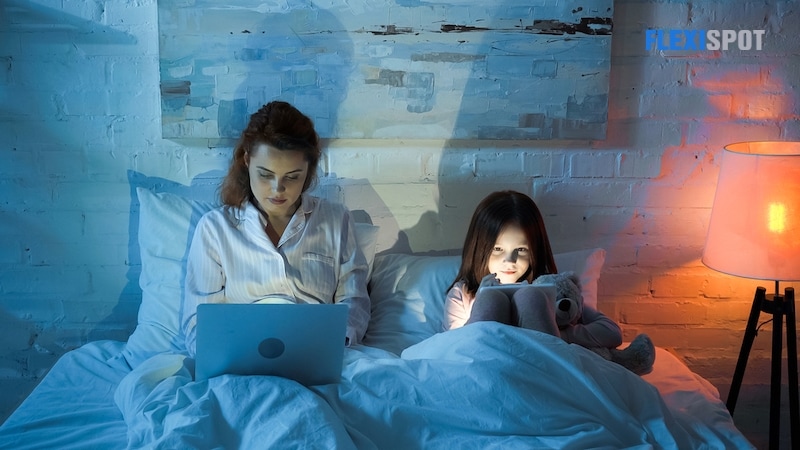In addition to our professional lives, technology is becoming more rampant and shared in our professional and personal lives. We check emails, post on social media, watch movie trailers, and conduct research, all of which affect the amount of blue light we are exposed to.
Although it is not entirely harmful, it is the most likely culprit of blue light damage to the eyes, eye fatigue, and migraines.
More than we know or want to admit, the deterioration of blue light to our eyes harms our health. To minimize the harmful effects of exposure to blue light, we need to learn to adapt to it healthily.
What is Blue Light and How Does It Work? Which Product Has The Bluest Light Emitted?
Blue light, which the human eye can perceive, is an example of visible light, and it has a short wavelength and is an efficient generator of energy.
Our eyes scan a lot of blue light in our environment, which causes eye damage. It is emitted by the sun unless you have filtered technology.
Blue light is emitted by cell phones, tablets, fluorescent lights, and televisions. While the sun is the primary source of blue light, it is also emitted by computers, smartphones, televisions, and tablets.
Despite being watched closer and longer than the sun, researchers are concerned about the blue light from screens. This may increase the development of cataracts in some people, so blue rays are harmful to the eyes.
In cases of digital eye strain, the risk of retina damage from extended exposure is very substantial. You do not need to be concerned; all is not lost. Your staff will be more awake during the day due to blue light because they can adjust their natural sleep cycle.
Distinguishing Natural Blue Light Between the Artificial Blue Light
Natural blue light has some beneficial properties. It boosts attentiveness, memory, and mental activity. It also lifts one's spirits. It also controls the 24-hour clock.
Artificial blue light, on the other hand, suppresses sleep chemicals like melatonin. This type of light has been linked to an increased risk of cancer.
Eye damage, eyestrain, and regular headaches are all on the rise. Furthermore, it raises the chance of developing heart disease, depression, diabetes, and obesity.
What Is Blue Light's Harmful Effect on the Eyes?
The human body remains awake during daylight hours and sleeps at night. Because blue light is produced by natural light, our bodies have evolved to suppress the hormone melatonin, which promotes sleepiness when exposed to it (from the sun).
So, what are the effects of blue light on your eyes? Artificial blue light is known to hurt hormones in the body, but scientists are not sure why.
By diminishing melatonin levels in the body, repeated exposure to bright light affects the immune system and natural sleep patterns.
The above health issues are directly influenced by a person's exposure to blue light. Blue light exposure causes eyestrain due to several factors:
Blue light tends to flicker because its wavelengths are shorter, which might cause glare that is harmful to the eyes.
Blue light, in particular, damages the retina and increases the risk of eye illnesses such as cataracts and glaucoma by penetrating the macular pigment of the eye.
The distance between your eyes and the screen might cause weariness and strain quickly. It was a terrific idea to take a break from the television!
Computer vision syndrome causes headaches, neck and back pain, dry and itchy eyes, and difficulties focusing, in addition to hazy vision. Digital eye strain has eclipsed carpal tunnel syndrome as the most common computer problem.
Everyone, regardless of age, is affected by blue light, and if not controlled, it can have long-term detrimental consequences, which is why blue light is harmful to your eyes.
What Kinds of Activities Can Cause Eye Strain?
Whether it is a smartphone, computer, or another device, all of the following digital devices can induce digital eye strain. The following are some effective eye strain prevention techniques:
There is no way to control the blue light
Blue light from digital screens, unlike white light, penetrates deeper into the eye, which is why it is so damaging. When you are exposed to light from digital devices, your circadian rhythm is disrupted. When you use these devices at night, your brain may be misled into thinking it is too early for you to retire for the night.
Poor posture
When you slouch over your computer screen or hold your portable digital device too near, your eyes have to work harder. The focusing muscles or tissues in your eyes are overworked as a result of this. A bad or wrong ergonomic sitting position can not only impair your vision but may also cause back pain and other problems.
Too close to the monitors
If you have bright lighting or glare on your computer, your eyes will have to work even more complicated. One solution is to figure out how far the monitor should be from the looks.
Existing eye or vision problems
Digital eye strain can be caused by astigmatism, presbyopia, nearsightedness, farsightedness, glaucoma, and disorders including glaucoma and cataracts.
Dry eyes
Furthermore, if you have dry eye syndrome, you may be more prone to developing digital eye strain. Having some on hand is a good idea if you need artificial tears while using your computer or other digital devices.
How to Make Blue Light Less Harmful to Your Eyes
There are many options for dealing with vision problems caused by digital screens. Regular eye care, appropriate workstation lighting, and changing how you view screens can usually help you solve these problems.
Stay More Active
Taking more breaks allows you to move around more frequently. Take a walk, eat a long lunch, and stretch your arms or legs instead of staring at your computer or smartphone.
Your productivity will increase if you incorporate this into your daily routine more often.
Using the 20-20-20 Rule
You can do this by staring at a 20-foot-away object for at least 20 seconds every 20 minutes. This gives your eyes a break from blue light exposure, and this, in turn, will benefit your eyesight and health immensely.
Having the Right Protective Gear
You should be equipped with the necessary computer glasses with a filter for blue light that reaches the eye.
These options should be made known to your employees. Explore specific eye protection for chemical or mechanical hazards if you employ staff working in that area.
Final Thoughts
Blue light exposure cannot be avoided, but it can be controlled. Adopt these methods so that you can protect your eyes.
Head on to flexispot.com for more articles related to employee health. Besides safeguarding your eyes from too much blue light exposure, you must also take care of your posture.
Check out the wide range of ergonomic office equipment on FlexiSpot, such as the Kana Bamboo Standing Desk and the Ergonomic Chair OC3B. Do not forget to visit FlexiWelness Center for more insightful blog posts.






